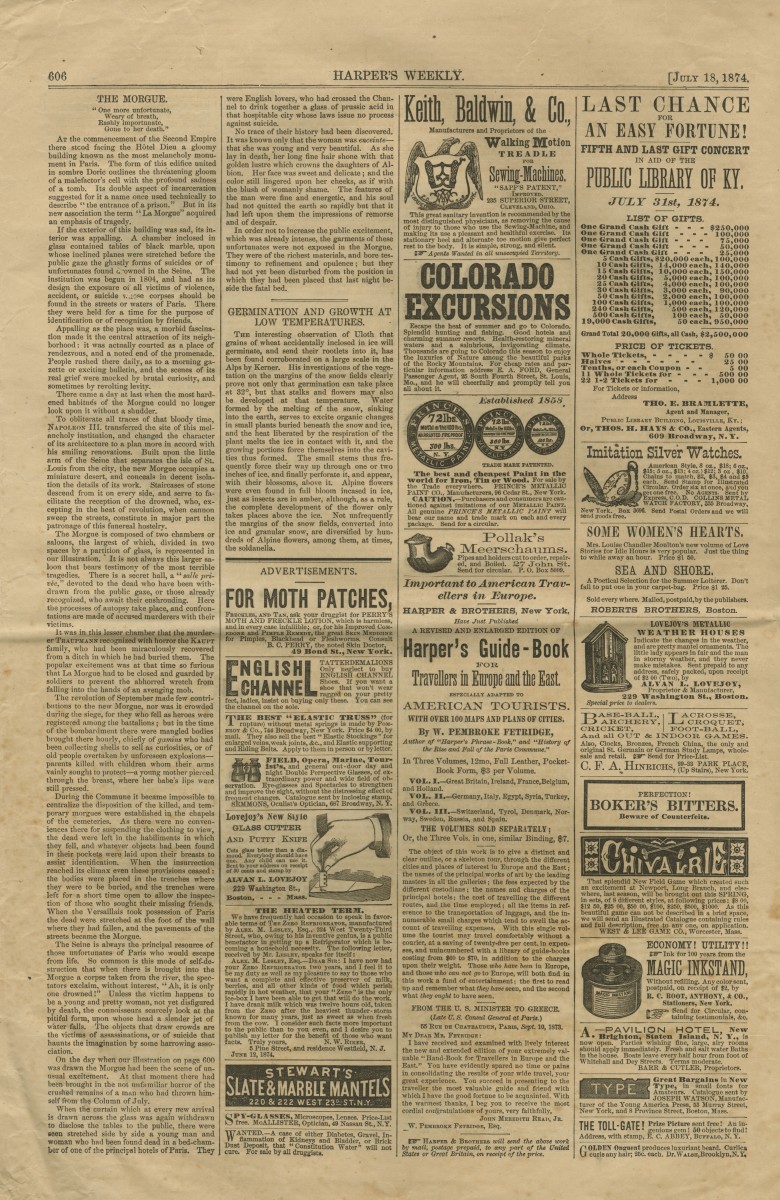-
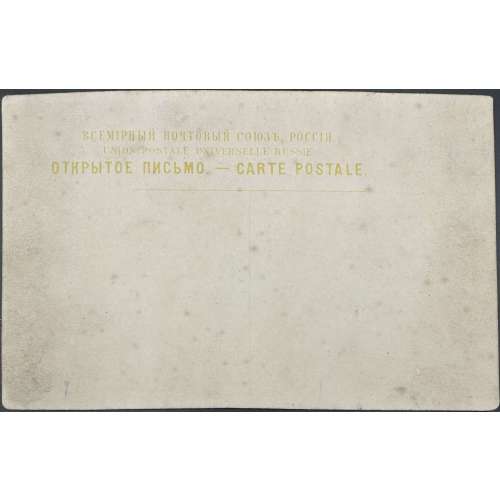 Ten postcards 90 x 140 mm, text in yellow "ВСЕМIРНЫЙ ПОЧТОВЫЙ СОЮЗЪ. РОССIЯ. | UNION POSTALE UNIVERSELLE RUSSIE. | ОТКРЫТОЕ ПИСЬМО. — CARTE POSTALE. || On the reverse, a blue ink woodcut image is printed in the upper left corner, and a blue ink numbered image title is in the bottom centre. Holding the postcard against the backlight reveals a hidden image of an indecent nature (erotic). The use of Latin characters "R" and "N" instead of Russian "Р" and "Н" suggests that the cards were produced in Europe, probably in France. Inscriptions: 1. ПЕRВЫЕ ДNИ; 2. ПОRА ЛЮБВИ; 3. ВЪ ЛЮДИ; 4. КЪ "СВОБОДNОМУ ИСКУССТВУ"; 5. "СВОБОДNЫЙ ТRУДЪ; 6. БЕЗЪ ГОRЯ И ПЕЧАЛИ; 7. NАЗАДЪ КЪ "СВОБОДNОЙ ЛЮБВИ"; 8. ВСЕ ЧТО ОСТАЛОСЬ!; 9. БЕЗЪ КRОВА И ПRИСТАNИЩА; 10. ИЗЪ ЗА ХЛѢБА.
Ten postcards 90 x 140 mm, text in yellow "ВСЕМIРНЫЙ ПОЧТОВЫЙ СОЮЗЪ. РОССIЯ. | UNION POSTALE UNIVERSELLE RUSSIE. | ОТКРЫТОЕ ПИСЬМО. — CARTE POSTALE. || On the reverse, a blue ink woodcut image is printed in the upper left corner, and a blue ink numbered image title is in the bottom centre. Holding the postcard against the backlight reveals a hidden image of an indecent nature (erotic). The use of Latin characters "R" and "N" instead of Russian "Р" and "Н" suggests that the cards were produced in Europe, probably in France. Inscriptions: 1. ПЕRВЫЕ ДNИ; 2. ПОRА ЛЮБВИ; 3. ВЪ ЛЮДИ; 4. КЪ "СВОБОДNОМУ ИСКУССТВУ"; 5. "СВОБОДNЫЙ ТRУДЪ; 6. БЕЗЪ ГОRЯ И ПЕЧАЛИ; 7. NАЗАДЪ КЪ "СВОБОДNОЙ ЛЮБВИ"; 8. ВСЕ ЧТО ОСТАЛОСЬ!; 9. БЕЗЪ КRОВА И ПRИСТАNИЩА; 10. ИЗЪ ЗА ХЛѢБА. -
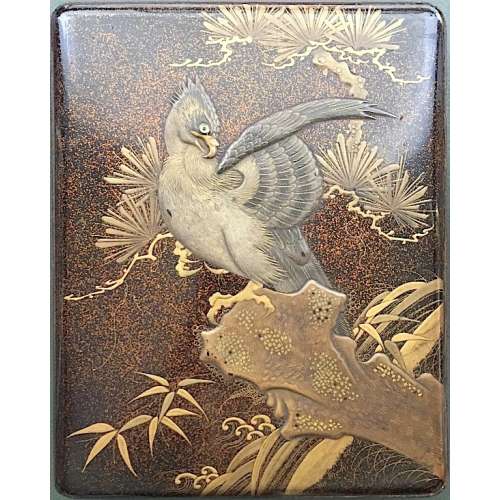 Japanese lacquer writing box (suzuribako) with an eagle sitting on a pine tree over the see waves. Rectangular box with rounded corners, slightly convex overlapping lid. Lacquer on wood with maki-e decoration in gold powder. The lid decorated inside with pine cones and needles over gold maki-e. Edo or Meiji period, 19th century.
Japanese lacquer writing box (suzuribako) with an eagle sitting on a pine tree over the see waves. Rectangular box with rounded corners, slightly convex overlapping lid. Lacquer on wood with maki-e decoration in gold powder. The lid decorated inside with pine cones and needles over gold maki-e. Edo or Meiji period, 19th century. -
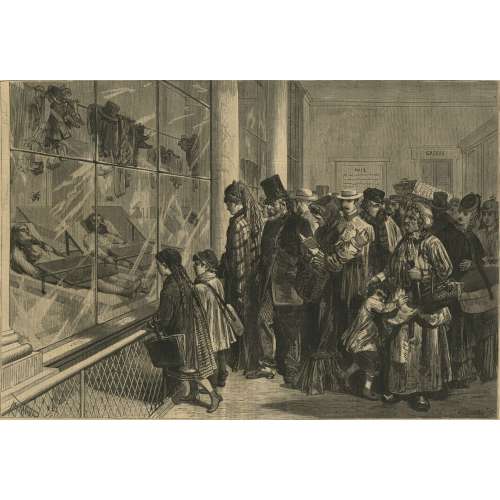
-
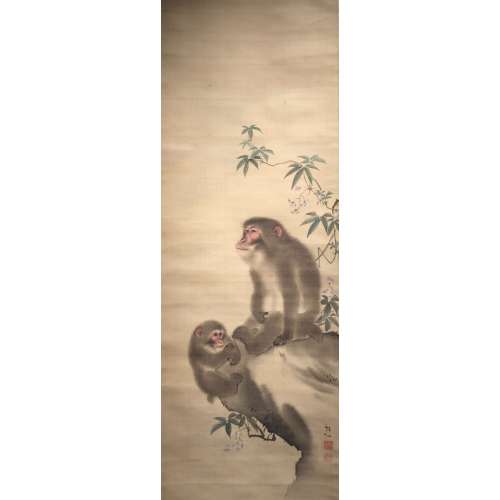 Mori Sosen (1747-1821). A Monkey Seated on a Rock with an Infant Monkey. Hanging scroll painting. Ink and colour on silk. Signed: Sosen. Sealed: Sosen. 108.3 x 38.3 cm. Provenance: According to the box inscriptions, the painting was in the possession of Itakura Katsunao, a daimyo lord in present-day Gunma, in 1808. In 1881, the painting was subsequently acquired by Negishi Shôrei (1833-1897) a master swordsman who established the Negishi school of shuriken ("The only specialist school to have survived is the Negishi-ryū, which was founded by Negishi Shorei in the mid-1800s".)
Mori Sosen (1747-1821). A Monkey Seated on a Rock with an Infant Monkey. Hanging scroll painting. Ink and colour on silk. Signed: Sosen. Sealed: Sosen. 108.3 x 38.3 cm. Provenance: According to the box inscriptions, the painting was in the possession of Itakura Katsunao, a daimyo lord in present-day Gunma, in 1808. In 1881, the painting was subsequently acquired by Negishi Shôrei (1833-1897) a master swordsman who established the Negishi school of shuriken ("The only specialist school to have survived is the Negishi-ryū, which was founded by Negishi Shorei in the mid-1800s".) -
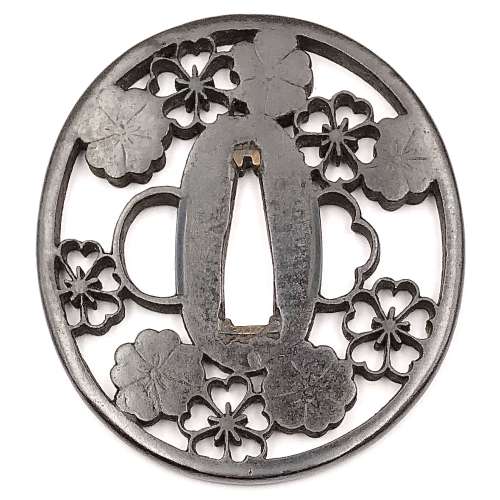 Iron tsuba of oval form with design of cherry blossoms in positive and negative silhouette openwork (ji-sukashi and in-sukashi). Details chiseled in kebori technique. Rounded rim. Copper sekigane. Higo school, Hayashi sub-school. Unsigned. Attributed to third generation Tōhachi (1723-1791). Edo period, 18th century (Hōreki / Meiwa era: 1751-1772). Height: 78.7 mm. Width: 72.2 mm. Rim thickness: 5.2 mm. Center thickness: 5.2 mm. Provenance: Sasano Masayuki Collection, № 289: "Hayashi. Third generation Tohachi (died in in the third year of Kansei, 1791 at the age of sixty-nine). Early 18th century (Hohreki / Meiwa era). "
Iron tsuba of oval form with design of cherry blossoms in positive and negative silhouette openwork (ji-sukashi and in-sukashi). Details chiseled in kebori technique. Rounded rim. Copper sekigane. Higo school, Hayashi sub-school. Unsigned. Attributed to third generation Tōhachi (1723-1791). Edo period, 18th century (Hōreki / Meiwa era: 1751-1772). Height: 78.7 mm. Width: 72.2 mm. Rim thickness: 5.2 mm. Center thickness: 5.2 mm. Provenance: Sasano Masayuki Collection, № 289: "Hayashi. Third generation Tohachi (died in in the third year of Kansei, 1791 at the age of sixty-nine). Early 18th century (Hohreki / Meiwa era). " -
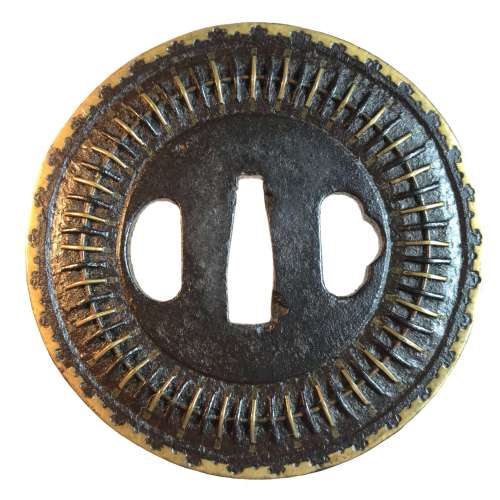 Mukade-zōgan tsuba with two types of wires. Iron, inlaid with brass and iron wire fastened to the surface with metal staples (mukade-zōgan); Brass inlay around the rim. Design is thought to resemble a centipede. "Centipede-like inlay (mukade zogan) of alternating iron and brass staples produce an appearance that was particularly favored by Takeda Shingen (1521-1573), one of the most powerful warlords of his time. The centipede is sacred to Bishamon (God of War) and especially propitious for a warrior. Shingen type, 16th century.” [The Peabody Museum collection of Japanese sword guards with selected pieces of sword furniture, by John D. Hamilton. Photographs by Mark Sexton. Salem, MA, 1975.] Height: 85.8 mm; Width 86.2 mm; Thickness at seppa-dai: 4.3 mm. Weight 177.6 g. Early Edo, 17th century. http://varshavskycollection.com/shingen-tsuba/
Mukade-zōgan tsuba with two types of wires. Iron, inlaid with brass and iron wire fastened to the surface with metal staples (mukade-zōgan); Brass inlay around the rim. Design is thought to resemble a centipede. "Centipede-like inlay (mukade zogan) of alternating iron and brass staples produce an appearance that was particularly favored by Takeda Shingen (1521-1573), one of the most powerful warlords of his time. The centipede is sacred to Bishamon (God of War) and especially propitious for a warrior. Shingen type, 16th century.” [The Peabody Museum collection of Japanese sword guards with selected pieces of sword furniture, by John D. Hamilton. Photographs by Mark Sexton. Salem, MA, 1975.] Height: 85.8 mm; Width 86.2 mm; Thickness at seppa-dai: 4.3 mm. Weight 177.6 g. Early Edo, 17th century. http://varshavskycollection.com/shingen-tsuba/ -
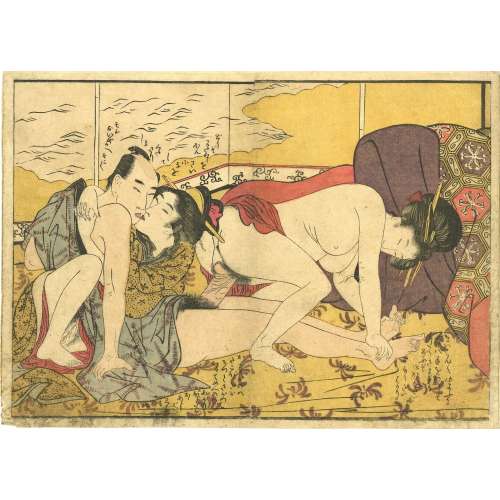 Kitagawa Utamaro. Illustration from the book Ehon koi no Onamaki. Cited at Hayashi Yoshikazu's 20-volume set Edo makura-e shi shusei: Kitagawa Utamaro. Size: Chuban (25.5 x 18.5 cm), two book pages glued together.
Kitagawa Utamaro. Illustration from the book Ehon koi no Onamaki. Cited at Hayashi Yoshikazu's 20-volume set Edo makura-e shi shusei: Kitagawa Utamaro. Size: Chuban (25.5 x 18.5 cm), two book pages glued together. -
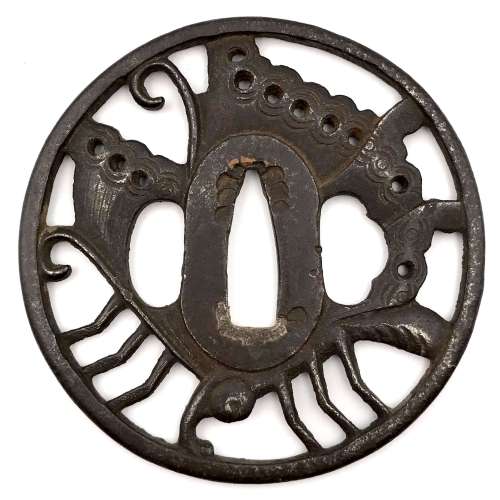 Iron tsuba of round form decorated with the design of a butterfly in openwork (sukashi) with details carved in kebori. Eyes inlaid in brass (one inlay is missing). Unsigned. Attributed to Bizen Shōami school, early Edo period (17th century). Dimensions: 80.4 x 80.6 x 4.4 mm References At Haynes Catalog #6, p. 18-19, Lot 30: "Famous Ikeda butterfly design" (Ikeda family of Inaba and Okayama, and at least 7 other families). Ca. 1700. Shōami of Kyoto, no doubt. Ht 8.2 cm, Th. 5 mm. ["Important tsuba, menuki, bokuto, woodblock prints, koshirae, sword pistol and kana mono". San Francisco, June 1-26, 1983. Catalog #6. Robert E. Haynes, Ltd.]Similar tsuba at Haynes Catalog #9, p.71, lot 143: the classic Shoami tsuba of the mon of the Ikeda family. This example, as most, seems to be made by the same hand as the others. See Haynes sale number 6, lot 30, for an identical example. The eye is brass. From an old French collection. Ht. 7.9 cm., Th. 5 mm.
Iron tsuba of round form decorated with the design of a butterfly in openwork (sukashi) with details carved in kebori. Eyes inlaid in brass (one inlay is missing). Unsigned. Attributed to Bizen Shōami school, early Edo period (17th century). Dimensions: 80.4 x 80.6 x 4.4 mm References At Haynes Catalog #6, p. 18-19, Lot 30: "Famous Ikeda butterfly design" (Ikeda family of Inaba and Okayama, and at least 7 other families). Ca. 1700. Shōami of Kyoto, no doubt. Ht 8.2 cm, Th. 5 mm. ["Important tsuba, menuki, bokuto, woodblock prints, koshirae, sword pistol and kana mono". San Francisco, June 1-26, 1983. Catalog #6. Robert E. Haynes, Ltd.]Similar tsuba at Haynes Catalog #9, p.71, lot 143: the classic Shoami tsuba of the mon of the Ikeda family. This example, as most, seems to be made by the same hand as the others. See Haynes sale number 6, lot 30, for an identical example. The eye is brass. From an old French collection. Ht. 7.9 cm., Th. 5 mm.
Haynes Catalog #6, lot 30.
Similar tsuba in the Randolph B. Caldwell Collection, 1994, page 24, №13: "A circular iron tsuba pierced in positive sukashi with a butterfly within an angular rim, details engraved. The eye inlaid in brass [in my specimen the inlay is missing on the omote side]. Unsigned. Bizen Shōami, Momoyama period. Dimensions: 8.0 x 8.2 x 0.5 cm. Similar example: Durand-Ruel, collection Ch. Gilloz, number 1302. [SV: that's possibly the 'old French collection' of Robert Haynes.]
Haynes Catalog #9, lot 143.
If we accept Haynes' theory regarding the genealogy and history of Bizen Shōami family, Momoyama period attribution would seem unlikely. I am leaning towards the early to mid 17th century.
Caldwell Collection, #13.
-
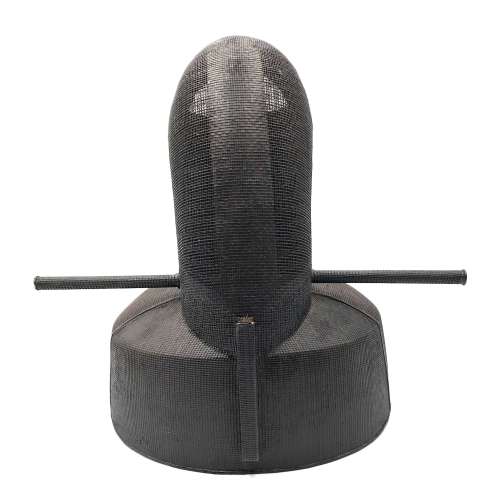 Kanmuri - a classic court cap, made of lacquered wood and paper. It is traditionally made by creating a skeleton, or harinuki, of paper on a wooden form. The outside of the hari-nuki is lacquered so as to keep its shape, and then the body of ra silk is layed on top. The entire thing is lacquered stiff.
Kanmuri - a classic court cap, made of lacquered wood and paper. It is traditionally made by creating a skeleton, or harinuki, of paper on a wooden form. The outside of the hari-nuki is lacquered so as to keep its shape, and then the body of ra silk is layed on top. The entire thing is lacquered stiff.Size: Height:20cm; Width: 21cm; Depth: 20cm.
Probably Taishō period (1912-1926), or later. Certain information is provided at http://www.sengokudaimyo.com/garb/garb.html In a wooden box without inscriptions. -
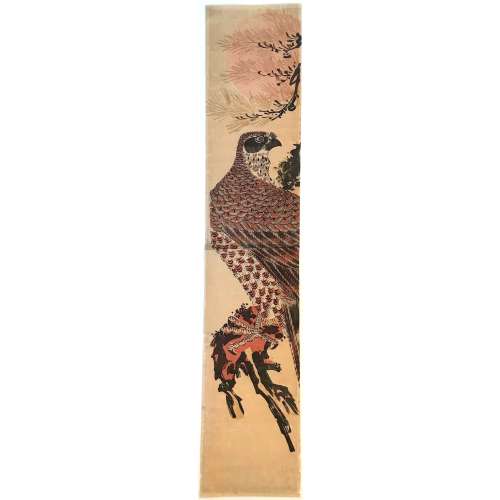 The print lacks signature. It is attributed by some to Suzuki Harunobu and by the others to Isoda Koryūsai.
The print lacks signature. It is attributed by some to Suzuki Harunobu and by the others to Isoda Koryūsai.Attributed to Koryūsai: Pins #517/p.209, c. 1775 [AIC II: Clarence Buckingham Collection, 1925.2772], Ukiyo-e Taisei IV; Vignier & Inada, 1911; Ritsumeikan University Z0165-239.
Attributed to Harunobu: Pins #239/p.132.; BM 1906,1220,0.85;
-
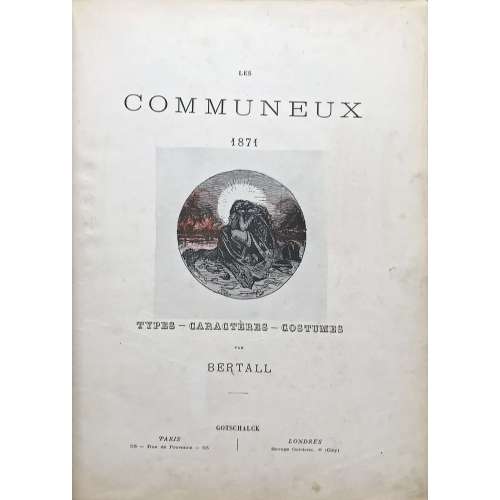 Folio (240 x 320 mm), hardbound in blue-aubergine cloth with gilt lettering and decoration. Album with Avant-Propos and 34 hand-colored lithographs by Bertall, numbered 1 through 34. Details in Russian: "Памяти парижской коммуны".
Folio (240 x 320 mm), hardbound in blue-aubergine cloth with gilt lettering and decoration. Album with Avant-Propos and 34 hand-colored lithographs by Bertall, numbered 1 through 34. Details in Russian: "Памяти парижской коммуны". -
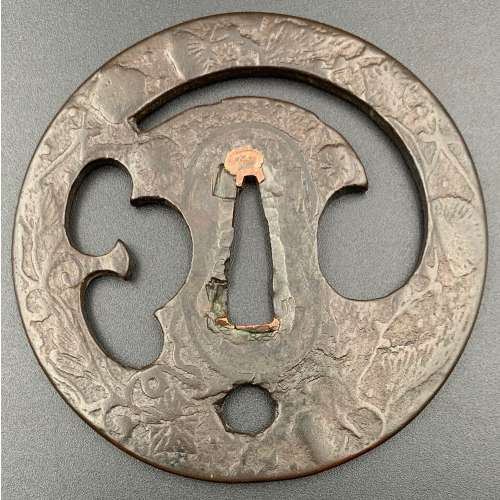
Yamagane (bronze) tsuba (kagami-shi, or mirror-maker) with the design of a star (round opening), tomoe (comma), and suhama in openwork. Surface cast and chiselled with the design of foliage, vines, blossoms, pine needles, and fruits on both sides.
The end of Early Muromachi period (1393-1453), circa 1450. Size: 83.7 x 84.1 x 3.6 (center), 4.1 (rim) mm; weight: 135.5 g. KANTEI-SHO (鑑定書) - APPRAISAL [translated by Markus Sesko]. No 463341 Tomoe-suhama-sukashi hana-karakusa no zu tsuba (巴洲浜透花唐草図鐔) ‒ Tsuba with stylized comma and bay inlet openwork and a flower and arabesque décor Unsigned: Kagami-shi (鏡師) Round shape, yamagane, hammer blow finish, cast, negative openwork design, round rim. According to the result of the shinsa committee of our society, we judge this work as authentic and rank it as Hozon Tōsōgu. July 1, 2011 [Foundation] Nihon Bijutsu Tōken Hozon Kyōkai, NBTHK (日本美術刀劍保存協會) -
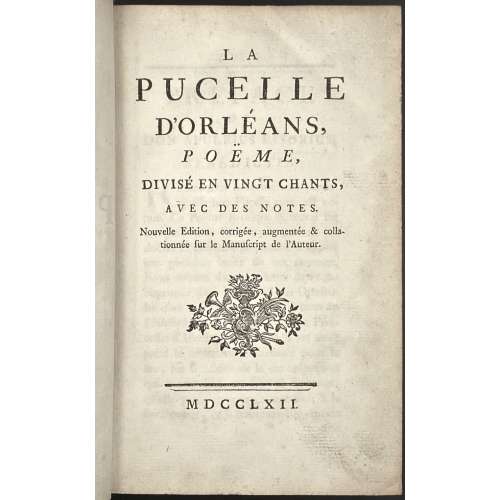 [François Marie Arouet de Voltaire]. La Pucelle d'Orléans, poëme, divisé en vingt chants, avec des notes. Nouvelle édition, corrigée, augmentée & collationnée sur le manuscript de l'auteur. – [Geneva: Gabriel Cramer], 1762.Illustrated book with 20 etchings and numerous woodcut vignettes.Illustrated by: Hubert-François Bourguignon, a.k.a. Gravelot (French, 1699–1773) Author: François Marie Arouet de Voltaire (French, 1694–1778) Printer: Gabriel Cramer (Swiss, 1723–1793)Pagination: [2 blanks, "Ex libris JCP" to recto] [2 - h.t., blank] [2 - t.p., blank], [i] ii-viii, [1] 2-358 [2 blanks]; 20 engraved plates, unsigned, one before every chant, by Gravelot (Hubert-François Bourguignon).Year of Publication: 1762Place of Publication: Geneva, SwitzerlandSize: 8vo, 19.8 x 12.6 x 3.7 cm.Binding: Full mottled calf, restored, flat spine, decorated in gilt, red labels with gilt lettering "Oeuvres de Voltaire; La Pucelle, tom XXII"; marbled endpapers and all margins.CATALOGUE RAISONNÉ: Cohen-de Ricci 1029.Mentions: MFA: ACCESSION NUMBER 25.701.Another copy in this collection: LIB-2580.2020.
[François Marie Arouet de Voltaire]. La Pucelle d'Orléans, poëme, divisé en vingt chants, avec des notes. Nouvelle édition, corrigée, augmentée & collationnée sur le manuscript de l'auteur. – [Geneva: Gabriel Cramer], 1762.Illustrated book with 20 etchings and numerous woodcut vignettes.Illustrated by: Hubert-François Bourguignon, a.k.a. Gravelot (French, 1699–1773) Author: François Marie Arouet de Voltaire (French, 1694–1778) Printer: Gabriel Cramer (Swiss, 1723–1793)Pagination: [2 blanks, "Ex libris JCP" to recto] [2 - h.t., blank] [2 - t.p., blank], [i] ii-viii, [1] 2-358 [2 blanks]; 20 engraved plates, unsigned, one before every chant, by Gravelot (Hubert-François Bourguignon).Year of Publication: 1762Place of Publication: Geneva, SwitzerlandSize: 8vo, 19.8 x 12.6 x 3.7 cm.Binding: Full mottled calf, restored, flat spine, decorated in gilt, red labels with gilt lettering "Oeuvres de Voltaire; La Pucelle, tom XXII"; marbled endpapers and all margins.CATALOGUE RAISONNÉ: Cohen-de Ricci 1029.Mentions: MFA: ACCESSION NUMBER 25.701.Another copy in this collection: LIB-2580.2020. -
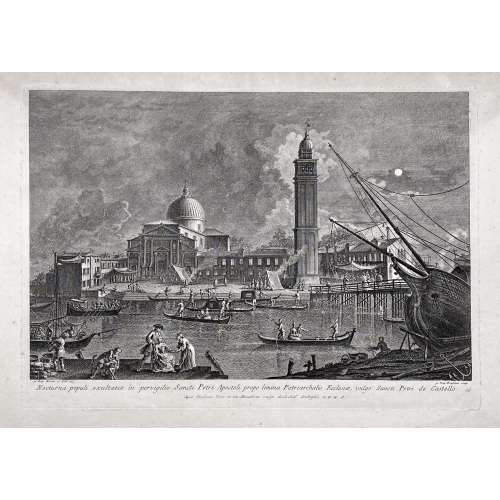
From the series of prints 'Prospectum Ædium Viarumque Insigniorum Urbis Venetiarum'. Inscribed below image left: "Jo. Bap. Moretti et Filii del. e Pinx."; right: "Jo. Baptista Brustoloni sculp."; in lower margin centre: "Nocturna populi exultatio in pervigilio Sancti Petri Apostoli prope limina Patriarchalis Ecclesiæ, vulgò Sancti Petri de Castello. / Apud Ludovicum Furlanetto supra Pontem vulgo dictum dei Baretteri C.P.E.S.". The third state, published by Teodoro Viero; the numbering on plate lower right, next to the inscription in Latin is cancelled as indicated by bibliography.
The subject is taken from a drawing by Giovanni Battista Moretti (Italian, active Venice, 1748-75) which in turn derives from a Canaletto painting. The print comes from the most important of Brustolon’s series, Prospectuum Aedium Viarumque Insignorum Urbis Venetiarum, dedicated to the Doge Marco Foscarini, from drawings by Canaletto, Moretti and sons and others, published for the first time by Ludovico Furlanetto in 1763 and later by Teodoro Viero. Giambattista Brustolon (1712–1796) was a famous Venetian engraver, a pupil of Joseph Wagner; whose talent is best displayed in his famous nocturnals: ‘riesce a dare il meglio di sé … nei famosi notturni’ (Succi).
Plate: 324 × 458 mm Sheet: 350 × 471 cm
References: The British Museum 1944,1014.209.48; The Metropolitan Museum of Art 60.611.29(4) (first state); Dario Succi, Da Carlevaris ai Tiepolo, 1983, pp.81-93, n. 55; William George Constable, J. G. Links, Canaletto: Giovanni Antonio Canal. 1697–1768. Oxford, 1989, vol. II, cat. no. 10, p. 674.
Condition: a very slight central fold, slight foxing and a very slight stain to the top, four small pinholes in corners, not affecting the engraving; else a well-margined copy in good condition.
-
![Jules Verne. Michael Strogoff : The courier of the Czar. (The story of the film). — London: The Readers Library Publishing Company Ltd., [1927]. — pp.: [1-13] 14-251 [252: printer's imprint] [253-256: blank], note: [note: first and last leaves used as front and rear paste-downs].](https://varshavskycollection.com/wp-content/uploads/2021/02/LIB-2460.2020-a-1-500x500.jpeg) First MGM edition, original maroon cloth, front and spine panels stamped in gold with decorations and lettering, partially darkened, wrap-around dust-jacket, chipped and torn near the head of spine with some loss, small chip and larger closed tear to lower panel. Photoplay edition. Film tie in edition for the 1926 French silent film which does not exist at this time in a full version. The front and rear panels depict scenes from the film. Bleiler (1978), p. 161. Not in Reginald (1979; 1992). Pagination: [2] – blank / advert., [2] – t.p. / coloph., [4] –advert. / editor's note, [2] – advert. / blank, [13] 14-251 [252: printer's imprint] [2] – blanks, note: [first and last leaves used as front and rear paste-downs]. Dimensions: 17 x 10.7 cm. Publisher: The Readers Library Publishing Company Ltd. (London). Publishing Year: 1927 (not indicated). Description of Shapero Rare Books, London: An attractive copy from this popular series of film editions, notable for their use of actors and scenes from the film version in question on the wrap-around dust-jacket, and sometimes photographic plates. A number of the film-makers involved were exiles from the Russian Revolution of 1917. The film's art direction was by Eduardo Gosch (Russian, American, 1890 – ?), César Lacca, Alexandre Lochakoff (Russian, French, fl. 1918–1939), Vladimir Meingard and Pierre Schild [Lakka Schildknecht] (Russian, Spanish, 1897 – 1968) who recreated the atmosphere of mid-nineteenth century Tsarist Russia. “Jules Verne has written no better book than this, in fact, it is deservedly ranked as one of the most thrilling tales ever written." Leonard S. Davidow, Classic Romances of Literature, 1937.
First MGM edition, original maroon cloth, front and spine panels stamped in gold with decorations and lettering, partially darkened, wrap-around dust-jacket, chipped and torn near the head of spine with some loss, small chip and larger closed tear to lower panel. Photoplay edition. Film tie in edition for the 1926 French silent film which does not exist at this time in a full version. The front and rear panels depict scenes from the film. Bleiler (1978), p. 161. Not in Reginald (1979; 1992). Pagination: [2] – blank / advert., [2] – t.p. / coloph., [4] –advert. / editor's note, [2] – advert. / blank, [13] 14-251 [252: printer's imprint] [2] – blanks, note: [first and last leaves used as front and rear paste-downs]. Dimensions: 17 x 10.7 cm. Publisher: The Readers Library Publishing Company Ltd. (London). Publishing Year: 1927 (not indicated). Description of Shapero Rare Books, London: An attractive copy from this popular series of film editions, notable for their use of actors and scenes from the film version in question on the wrap-around dust-jacket, and sometimes photographic plates. A number of the film-makers involved were exiles from the Russian Revolution of 1917. The film's art direction was by Eduardo Gosch (Russian, American, 1890 – ?), César Lacca, Alexandre Lochakoff (Russian, French, fl. 1918–1939), Vladimir Meingard and Pierre Schild [Lakka Schildknecht] (Russian, Spanish, 1897 – 1968) who recreated the atmosphere of mid-nineteenth century Tsarist Russia. “Jules Verne has written no better book than this, in fact, it is deservedly ranked as one of the most thrilling tales ever written." Leonard S. Davidow, Classic Romances of Literature, 1937. -
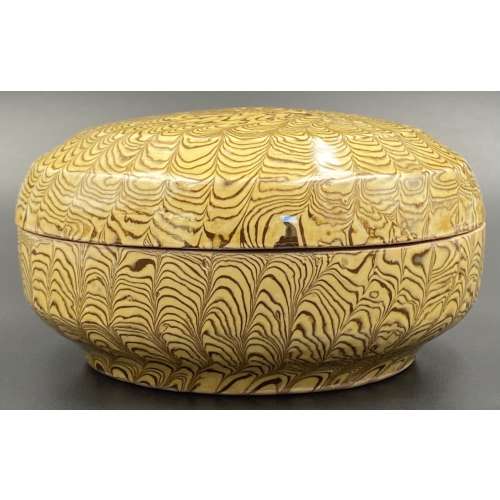 Press moulded round box with a cover made of yellow and brown marble clay, glazed with a clear glaze inside and outside. China, the Tang dynasty [唐朝] (618 – 907) Diameter: 11 cm; Height: 5.5 cm.
Press moulded round box with a cover made of yellow and brown marble clay, glazed with a clear glaze inside and outside. China, the Tang dynasty [唐朝] (618 – 907) Diameter: 11 cm; Height: 5.5 cm. -
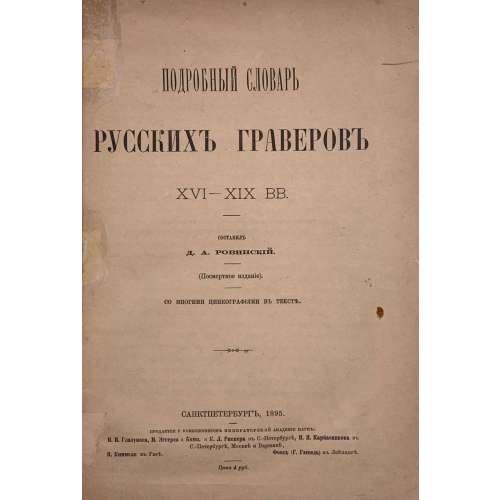 Title: ПОДРОБНЫЙ СЛОВАРЬ | РУССКИХЪ ГРАВЕРОВЪ | XVI-XIX ВВ. | СОСТАВИЛЪ Д. А. РОВИНСКIЙ. | (ПОСМЕРТНОЕ ИЗДАНIЕ). | СО МНОГИМИ ЦИНКОГРАФIЯМИ ВЪ ТЕКСТѢ. | САНКТПЕТЕРБУРГЪ, 1895. | ПРОДАЕТСЯ У КОМИССIОНЕРОВЪ ИМПЕРАТОРСКОЙ АКАДЕМИИ НАУКЪ: | И. И. Глазунова, М. Эггерса и Комп. и К. Л. Риккера въ С.-Петербургѣ, Н. П. Карбасникова въ | С.-Петербургѣ, Москвѣ и Варшавѣ, | Н. Киммеля въ Ригѣ. Фоссъ (Г. Гэссель) въ Лейпцигѣ. | Цена 4 руб. Pagination: [2] t.p./colophon, [2] dedication/blank, [2] f.t. ИСТОРИЧЕСКIЙ ОБЗОРЪ | ГРАВИРОВАНIЯ / blank; 1-344 (numbered half-pages, 86 leaves); [2] f.t. СЛОВАРЬ ГРАВЕРОВЪ. / blank, 1-806 [808 blank] (numbered half-pages, 202 leaves) Collation: 8vo; π3 1-258 262. Книга состоит из двух разделов с раздельной пагинацией. Первая часть "Исторический обзор гравирования", вторая – собственно "Словарь граверов". В обеих частях пронумерованы половины страниц.
Title: ПОДРОБНЫЙ СЛОВАРЬ | РУССКИХЪ ГРАВЕРОВЪ | XVI-XIX ВВ. | СОСТАВИЛЪ Д. А. РОВИНСКIЙ. | (ПОСМЕРТНОЕ ИЗДАНIЕ). | СО МНОГИМИ ЦИНКОГРАФIЯМИ ВЪ ТЕКСТѢ. | САНКТПЕТЕРБУРГЪ, 1895. | ПРОДАЕТСЯ У КОМИССIОНЕРОВЪ ИМПЕРАТОРСКОЙ АКАДЕМИИ НАУКЪ: | И. И. Глазунова, М. Эггерса и Комп. и К. Л. Риккера въ С.-Петербургѣ, Н. П. Карбасникова въ | С.-Петербургѣ, Москвѣ и Варшавѣ, | Н. Киммеля въ Ригѣ. Фоссъ (Г. Гэссель) въ Лейпцигѣ. | Цена 4 руб. Pagination: [2] t.p./colophon, [2] dedication/blank, [2] f.t. ИСТОРИЧЕСКIЙ ОБЗОРЪ | ГРАВИРОВАНIЯ / blank; 1-344 (numbered half-pages, 86 leaves); [2] f.t. СЛОВАРЬ ГРАВЕРОВЪ. / blank, 1-806 [808 blank] (numbered half-pages, 202 leaves) Collation: 8vo; π3 1-258 262. Книга состоит из двух разделов с раздельной пагинацией. Первая часть "Исторический обзор гравирования", вторая – собственно "Словарь граверов". В обеих частях пронумерованы половины страниц. -
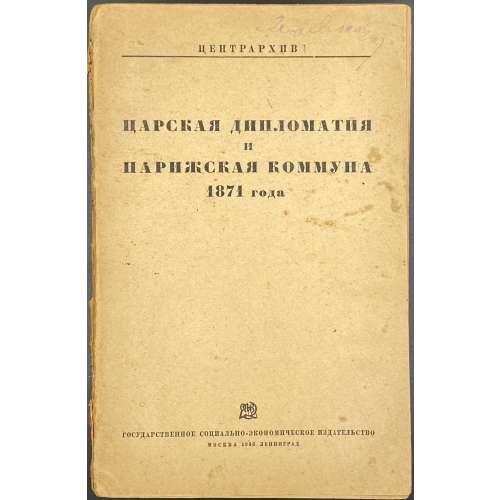 Front cover: ЦЕНТРАРХИВ | [—] | ЦАРСКАЯ ДИПЛОМАТИЯ | И | ПАРИЖСКАЯ КОММУНА | 1871 года | [blank space] [publisher's device] | ГОСУДАРСТВЕННОЕ СОЦИАЛЬНО-ЭКОНОМИЧЕСКОЕ ИЗДАТЕЛЬСТВО | МОСКВА 1933 ЛЕНИНГРАД || Title: ЦЕНТРАРХИВ | [—] | ЦАРСКАЯ ДИПЛОМАТИЯ | И | ПАРИЖСКАЯ КОММУНА | 1871 года | ПОД РЕДАКЦИЕЙ И С ПРЕДИСЛОВИЕМ | Ц. ФРИДЛЯНДА | [blank space] [publisher's device] | ГОСУДАРСТВЕННОЕ СОЦИАЛЬНО-ЭКОНОМИЧЕСКОЕ ИЗДАТЕЛЬСТВО | МОСКВА 1933 ЛЕНИНГРАД || [Центральное архивное управление при ВЦИК РСФСР]. Pagination: [2] 3-238 [2]. Softcover, editor's wrappers, lettering to covers and spine. 23 x 15 cm; Printrun (Тираж): 2000 экз.
Front cover: ЦЕНТРАРХИВ | [—] | ЦАРСКАЯ ДИПЛОМАТИЯ | И | ПАРИЖСКАЯ КОММУНА | 1871 года | [blank space] [publisher's device] | ГОСУДАРСТВЕННОЕ СОЦИАЛЬНО-ЭКОНОМИЧЕСКОЕ ИЗДАТЕЛЬСТВО | МОСКВА 1933 ЛЕНИНГРАД || Title: ЦЕНТРАРХИВ | [—] | ЦАРСКАЯ ДИПЛОМАТИЯ | И | ПАРИЖСКАЯ КОММУНА | 1871 года | ПОД РЕДАКЦИЕЙ И С ПРЕДИСЛОВИЕМ | Ц. ФРИДЛЯНДА | [blank space] [publisher's device] | ГОСУДАРСТВЕННОЕ СОЦИАЛЬНО-ЭКОНОМИЧЕСКОЕ ИЗДАТЕЛЬСТВО | МОСКВА 1933 ЛЕНИНГРАД || [Центральное архивное управление при ВЦИК РСФСР]. Pagination: [2] 3-238 [2]. Softcover, editor's wrappers, lettering to covers and spine. 23 x 15 cm; Printrun (Тираж): 2000 экз.



